
| WWT Shows | CLICK TO: Join and Support Internet Horology Club 185™ | IHC185™ Forums |

|
• Check Out Our... • • TWO Book Offer! • |
Welcome Aboard IHC185™  Internet Horology Club 185
Internet Horology Club 185  IHC185™ Discussion Site Main Page
IHC185™ Discussion Site Main Page  Interesting Horologically Based Stories
Interesting Horologically Based Stories  Larry Buchan's ..."Tales from the Rails"
Larry Buchan's ..."Tales from the Rails"  BofRT ID Tag [Accident - Health Reference]
BofRT ID Tag [Accident - Health Reference]
 Internet Horology Club 185
Internet Horology Club 185  IHC185™ Discussion Site Main Page
IHC185™ Discussion Site Main Page  Interesting Horologically Based Stories
Interesting Horologically Based Stories  Larry Buchan's ..."Tales from the Rails"
Larry Buchan's ..."Tales from the Rails"  BofRT ID Tag [Accident - Health Reference]
BofRT ID Tag [Accident - Health Reference]Page 1 2
Go  | New Topic  | Find-Or-Search  | Notify  | Tools  | Reply to Post  |  |
| IHC Life Member |
I recently bought this Brotherhood of Railroad Trainmen tag on E-bay and am curious how old it is. I know some forum members have been railroad employees and, hopefully, they can enlighten me. The front reads "Brotherhood of Railroad Trainmen - BofRT - Accident - Health" | ||
|
| IHC Life Member |
The back reads, "If injured or unconscious, to identify me - [60156] - telegraph this number to the Brotherhood of Railroad Trainmen, Cleveland, Ohio." The word "telegraph" suggests to me the tag is from the early 1900's. Any information would be appreciated. | |||
|
| Railway Historian IHC Life Member Site Moderator |
One interesting aspect about in the development and operation of the railroads in North America is the history of its railroad labor organizations. In the 1860's railroading was a very dangerous occupation. It was so dangerous that no locomotive engineer, fireman, conductor, or trainman could get insurance this due to the many accidents that resulted from substandard track, bridges, and unsafe equipment. The working conditions at this time were also very deplorable hours were long and pay was poor. The need for improved working conditions, and some kind of insurance for those who might be stricken by illness, injury or death was instrumental in the formation of the Brotherhoods. When the Brotherhood of Railroad Trainmen organized on September 23, 1883, they followed the Brotherhood of Locomotive Engineers in 1863, the Order of Railway Conductors in 1868, and the Brotherhood of Locomotive Firemen in 1873 providing life insurance to their membership. I have a couple of these identification tags in my collection, I would date them to about the 1930s on to 1969 when the Brotherhood of Railroad Trainman merged with the Order of Railway Conductors, the Brotherhood of Locomotive Firemen and Enginemen, and the Switchman's Union of North America to form the United Transportation Union. | |||
|
| Railway Historian IHC Life Member Site Moderator |
These identification tags came in both bronze and silver colored.I have one of each, the earlier identification tag is in good condition, the second one is well-worn almost through the retaining ring. | |||
|
| Railway Historian IHC Life Member Site Moderator |
Here is an example of an earlier identification tag from around the turn-of-the-century, that is blank. Organized in Sedalia, Missouri in 1899 by 33, as the Order of Railroad Clerks of America, it renamed itself as the Brotherhood of Railway Clerks, and in 1919. It renamed itself as the "Brotherhood of Railway and Steamship Clerks, Freight Handlers, Express and Station Employees", commonly known as BRAC. Here is one of their identification tags from around the turn-of-the-century, I've seen other examples from the Brotherhood of Railroad Trainman. 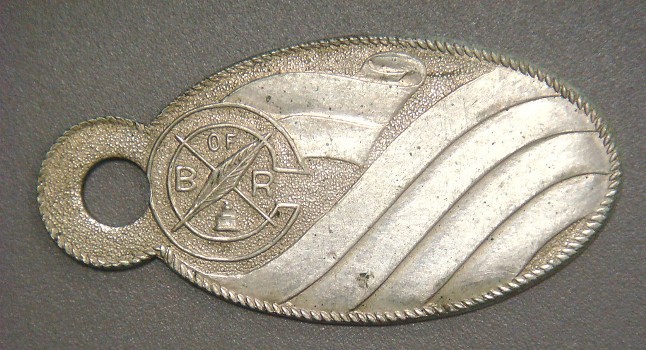 | |||
|
| Railway Historian IHC Life Member Site Moderator |
As you can see in this photo rendition titled "Braking in Hard Weather." how hazardous a Railroad Trainman's occupation can be when descending grades in winter conditions, the trainman must apply handbrakes by hand on, say, one third or one half the cars, it will perhaps be found that one or two brakes too many have been put on and that the train is running too slowly. Some of them must be loosened. Or perhaps some are set so tightly that the friction heats the wheels unduly or causes them to slide along the track. Instead of rolling; then those brakes must be released and some on other cars applied instead; and all this must be done (sometimes for an hour) when the temperature is 20° below zero, or the wind is blowing a gale, just as under more favorable circumstances. A train moving at 20 miles an hour against a wind with a velocity of 30 miles an hour increases the latter to 50, so far as the brakeman is concerned; and if rain or sleet is falling, the force of it on his hands and face is very severe 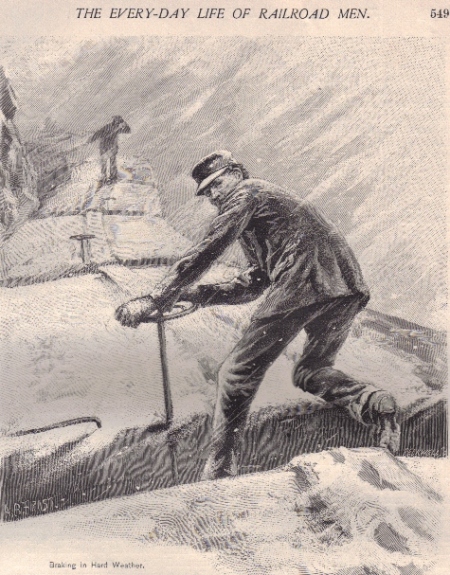 | |||
|
| IHC Life Member |
Larry, Thank you for your good information. Another dangerous aspect of early railroading were link and pin couplers. They required a man to stand between the cars as they came together, guide the link into the pocket on the next car, and insert the pin to hold them together. I've read that management was more concerned about pilferage of the loose coupling parts than the high number of injuries and deaths they caused. | |||
|
| IHC Member 163 |
I've also read that 'boomers' (traveling railroaders) were hired as temporary workers when they were all asked to hold up their hands. The ones with the most missing fingers were hired as it proved to the supervisor that they were willing to actually get between the cars to drop the pin and therefore had 'experience' on a previous job. Wow. Regards! Mark | |||
|
| Railway Historian IHC Life Member Site Moderator |
Father Lorenzo Stephen Coffin, farmer, agriculture leader, social reformer, and humanitarian was born in 1824 at Alton, New Hampshire, and passed away in 1915. He went to Oberlin College in Ohio and his religious upbringing and use exposure to social reform, molded his thinking and activities for the rest of his life. In 1854 he moved to Iowa and started a farm of 160 acres. The new land was not kind to Coffin. His wife died soon after their arrival and he lost his crops to prairie fires, and grasshoppers. For 17 years he in a small cabin. With the outbreak of the Civil War, Coffin, moved by abolitionist fervor, volunteered his service and was assigned to the 32nd Iowa Infantry. He advance rapidly up the ranks from private to sergeant, receiving special recognition for his bravery and leadership. Later he was appointed regimental chaplain. After the Civil War, Coffin returned to farming. His farm Willowedge, became one of show places of progressive farming. He achieved great success in stock raising, introducing purebred varieties hogs, sheep, cattle, and horses, and he was registered for his efforts by being elected president of the Iowa Breeders Association. In 1883 he was appointed to the Iowa Railroad Commission. It was in this role that he first became aware of the safety problems that railroad employees faced. Railroading in the post Civil War period was the nation's most hazardous occupation. According to Coffin, in 1881 alone, more than 30,000 men were either killed or maimed in rail accidents. Coffin's personal observation of a brakeman, losing his fingers in the fact of switching cars led him to become a self proclaimed spokesmen for workers' interests. For 10 years Coffin spent much of his time trying to arouse the public to the extent of the problem. He lobbied for the adoption of state and federal safety legislation. A bill requiring automatic couplers and air brakes finally became law in 1893. Coffin's railroad reforms did not stop with safety laws. He advocated without success a Sunday no work law; he organized the Railroad Men's Temperance Association; through his efforts, a Railroad men's retirement home was established in Highland Park, Illinois, this was jointly funded by the railroad Brotherhoods and Orders starting out in an old frame house, for the indigent and infirm railroad workers and an annex for the wheelchair-bound brothers could be looked after, and he worked to create a railroad men's Young Men's Christian Association (YMCA) as an alternative to the street life and saloons. 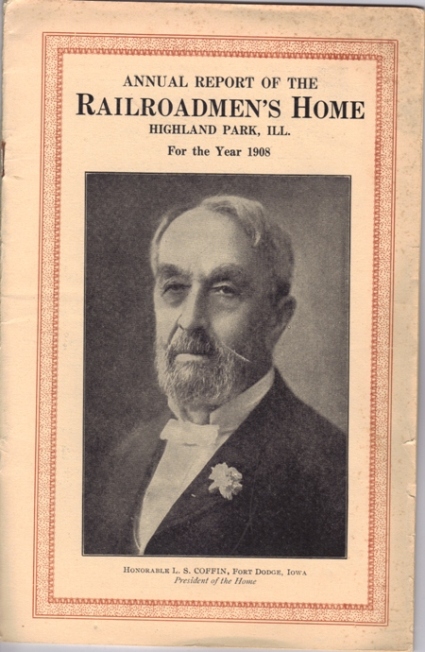 | |||
|
| Railway Historian IHC Life Member Site Moderator |
A photo of the first Brotherhood Home and Annex in Highland Park, Illinois, a much larger and modern facilities was built in the 1940s. In 1908 there was no such thing as a railway pension, this was very hard conditions for the indigent and infirm. 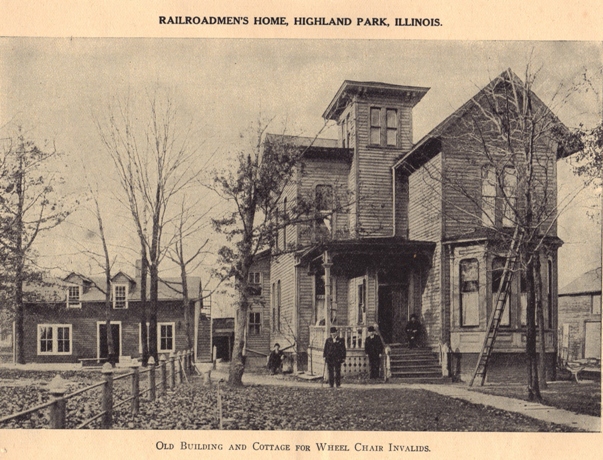 | |||
|
| Railway Historian IHC Life Member Site Moderator |
This photo "Broken Rails" is a sad statement from the broken lives of the men pictured, with their missing hands, rubber prosthetics, and hooks, at least they are well Clothed, and fed. 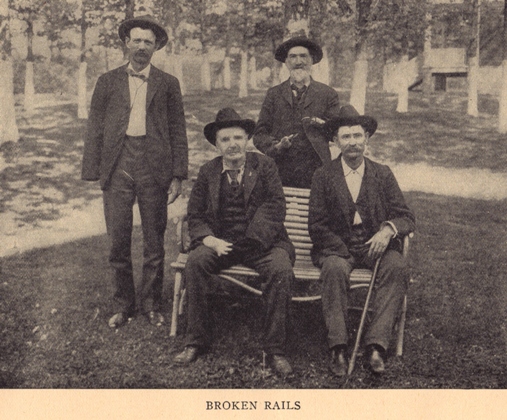 | |||
|
| IHC Life Member |
All very interesting. Thank you! | |||
|
| Administrative Assistant |
Larry, Thank you for sharing this information! Debbie | |||
|
| IHC Member 1541 |
Larry, odd that I should today stumble upon some related info about the Brotherhood Home. Railroad Man's Magazine 1911. 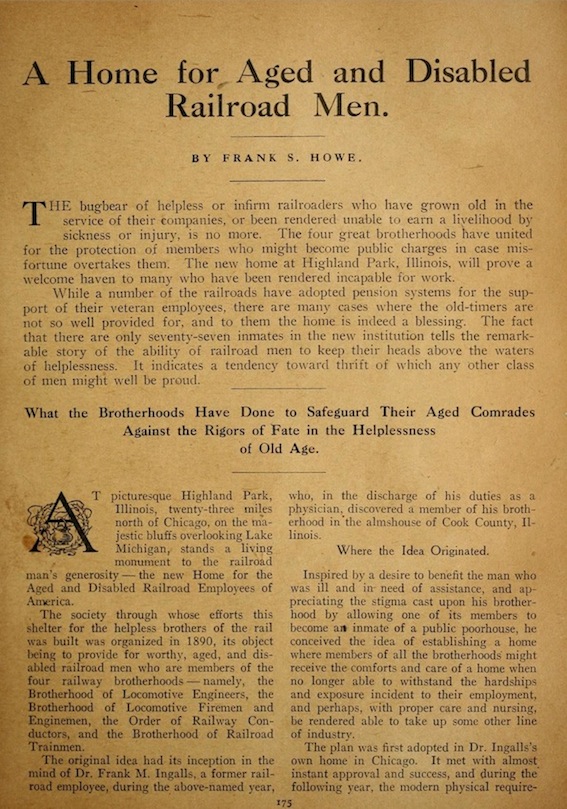 | |||
|
| IHC Member 1541 |
2. 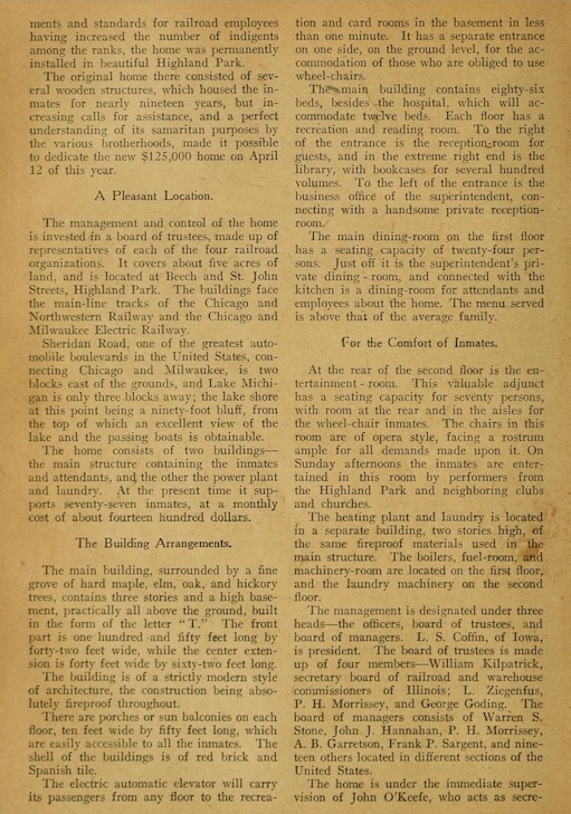 | |||
|
| IHC Member 1541 |
3. 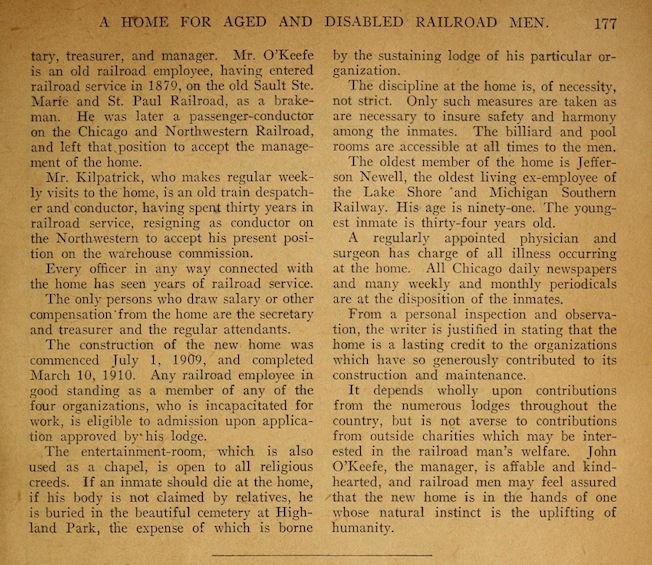 | |||
|
| IHC Member 1541 |
4. 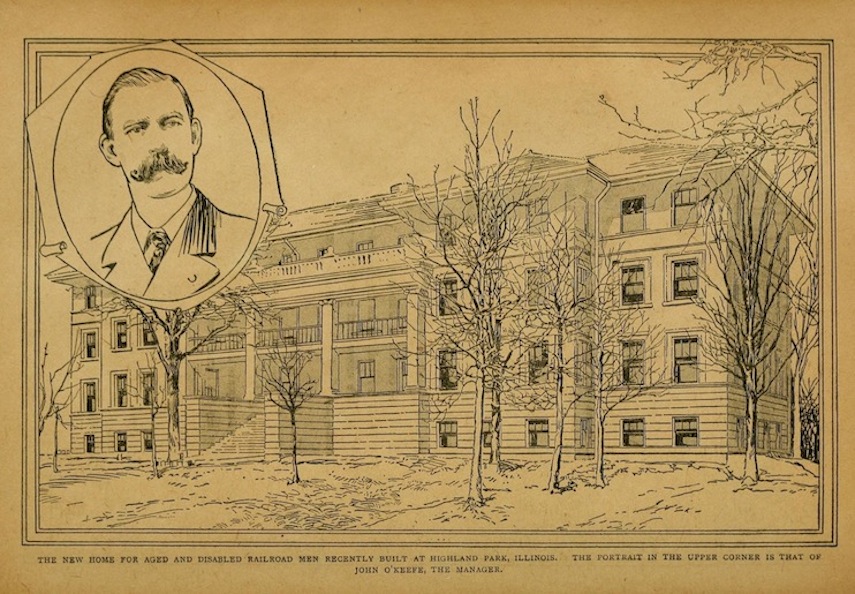 | |||
|
| Railway Historian IHC Life Member Site Moderator |
L. Zigenfuz was from the Brotherhood of Locomotive Engineers, and was a big fundraiser for the Brotherhood Home. PH Morrissey was a Grand Master of the. Brotherhood of Railroad Trainmen, Warren S Stone was the president of the Brotherhood of Locomotive Engineers, John J Hanrahan was an officer of the Brotherhood of Locomotive Firemen & Enginemen, A.B. Garretson was the Grand Chief Conducter of the Order of Railway Conductors, Frank P. Sergeant was a Grand Master of the Brotherhood of Locomotive Firemen, here is a photo of the grand opening ceremony of the new Brotherhood Home with the governor of Illinois, addressing the people present on April 12, 1910. 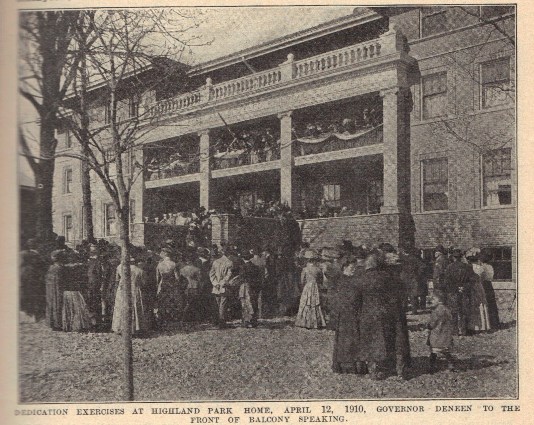 | |||
|
| Railway Historian IHC Life Member Site Moderator |
Here is a commemorative watch fob from the Hiberian Bank of Chicago 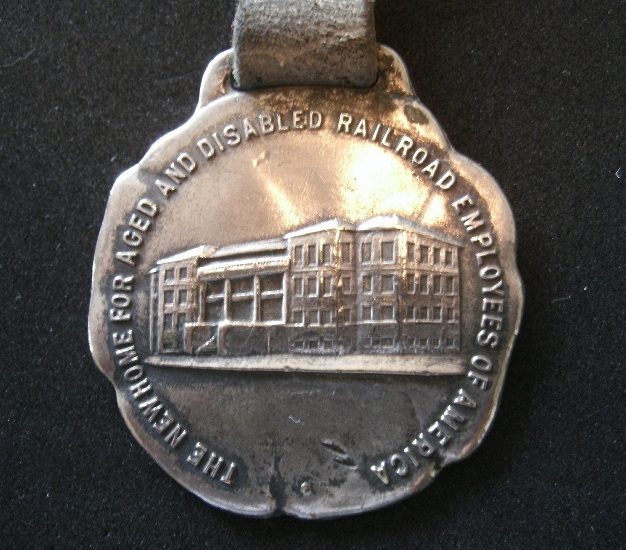 | |||
|
| Railway Historian IHC Life Member Site Moderator |
Backside  | |||
|
| Railway Historian IHC Life Member Site Moderator |
A postcard view of the Home for the Aged and Disabled Railroadmen of the USA and Canada from my collection. 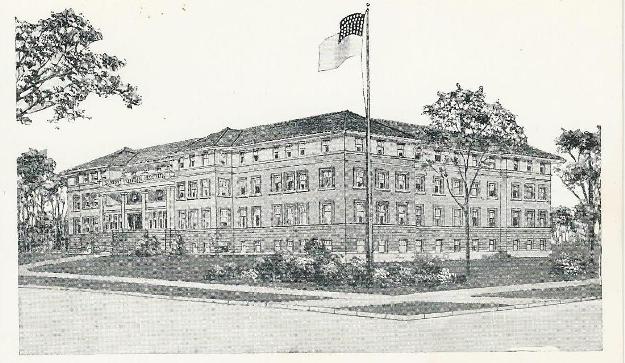 | |||
|
A true story on my first week as a asst. signalman on the new Haven Railroad. During a blizzard we had a report of a signal displaying stop and proceed. The maintainer with 35 years service working in the Windsor area asked the boss if he could take me along to help. We drove up to a location five miles from State Line and started walking south. The wind was hitting me in the face and his instructions to me were "Keep your Head on a swivel Kid and you wont loose it". A mile or so into the walk he yelled to me to look at a broken rail he found on his track. I stepped from between the rails of my track towards his track and a fast mail express [79 MPH}went by on my track"Against the "Normal currant of Traffic". I was in the "Six Foot" an area separating the tracks. At the young age of twenty I took the near miss in stride but the old maintainer was very shaken. He was shook that I was nearly hit on his watch while I worried about getting yelled at by the Boss when we got back. Conditions were so awful he had forgotten to remind me they were running both directions on my track due to the fear of a break in the rail on his track. One of hundreds of memory's working on the railroad I live with. Luck was with me that day and many others as well..... | ||||
|
| Railway Historian IHC Life Member Site Moderator |
Great story Bill about working as a signal maintainer on the New York New Haven and Hartford Railroad, I have a Hamilton 992 presentation watch that dates back to the times of the electrification of the railroad. It's serial number is 1043883, dating it to 1913 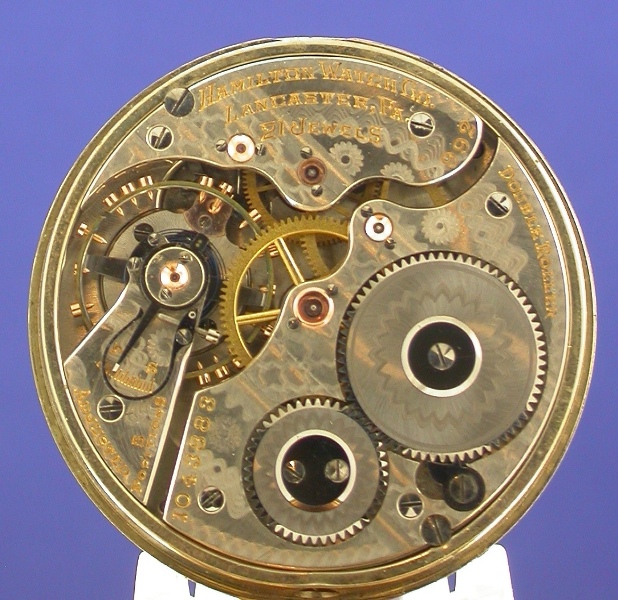 | |||
|
| Railway Historian IHC Life Member Site Moderator |
It Is, lever set with a double sunk bold Arabic dial marked Hamilton in script. 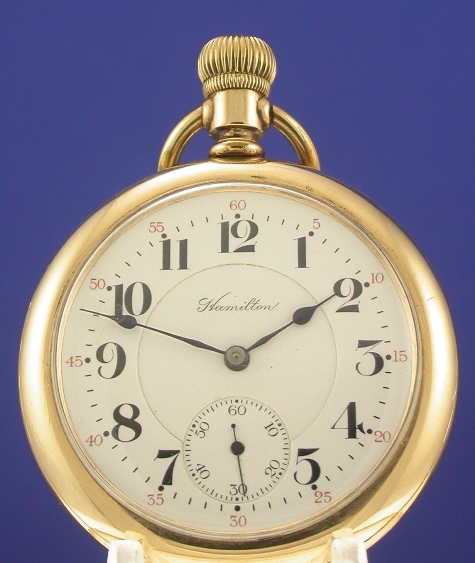 | |||
|
| Railway Historian IHC Life Member Site Moderator |
Dial 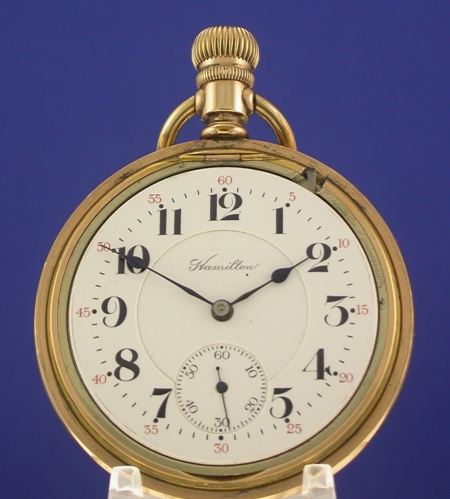 | |||
|
| Railway Historian IHC Life Member Site Moderator |
Cased in a Crescent Watch Case Co. 25 year yellow gold filled swing ring case. 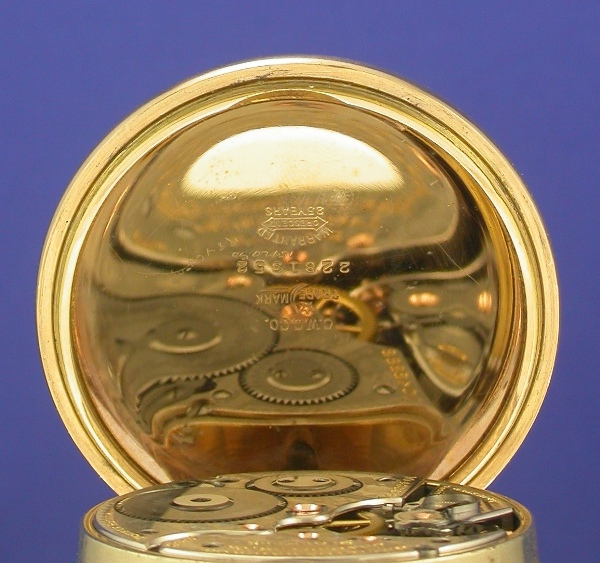 | |||
|
| Railway Historian IHC Life Member Site Moderator |
Case back 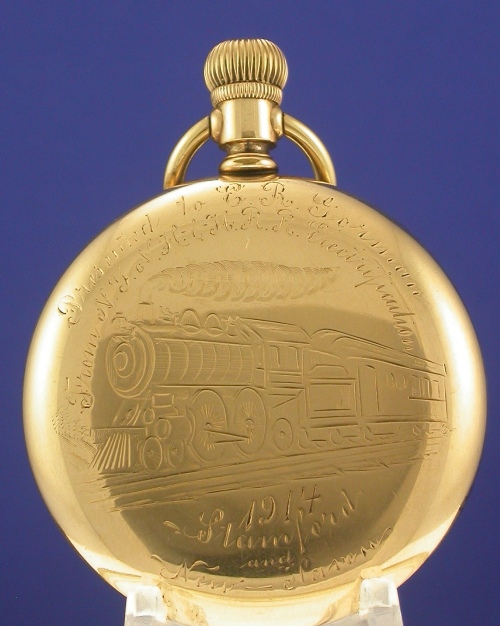 | |||
|
| Railway Historian IHC Life Member Site Moderator |
That is Inscribed on the back on top. "Present to E.R. Gorman From N.Y. N. H. & H. R.R. Electrification" with an Atlantic steam locomotive in the middle and "1914 Stanford and New Haven" on the bottom. I look forward to hearing more of your stories from the New Haven Bill Larry 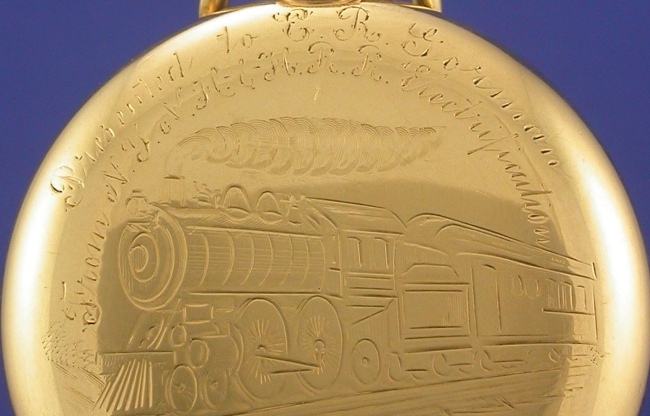 | |||
|
| Railway Historian IHC Life Member Site Moderator |
Bottom inscription  | |||
|
| Railway Historian IHC Life Member Site Moderator |
I found a couple of other turn-of-the-century identification tags for trainmen front view. 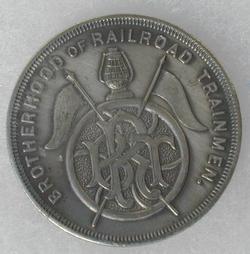 | |||
|
| Railway Historian IHC Life Member Site Moderator |
back side 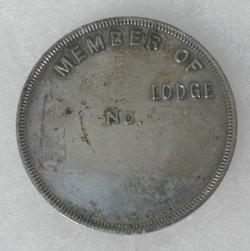 | |||
|
| Railway Historian IHC Life Member Site Moderator |
Here is another Brotherhood of Railroad Trainmen identification tag for HL Stalcup , a member of Lodge 187, Buffalo, New York, who worked for the Pennsylvania Railroad. 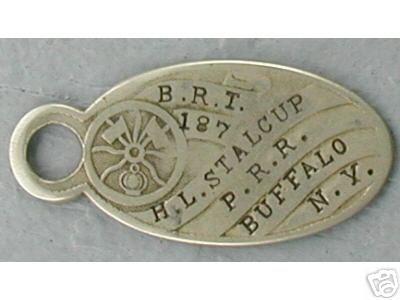 | |||
|
| Railway Historian IHC Life Member Site Moderator |
Here is an occupational shaving mug from my collection,looking at the link pin couplers, there is no doubt what W Murphy did for a living. 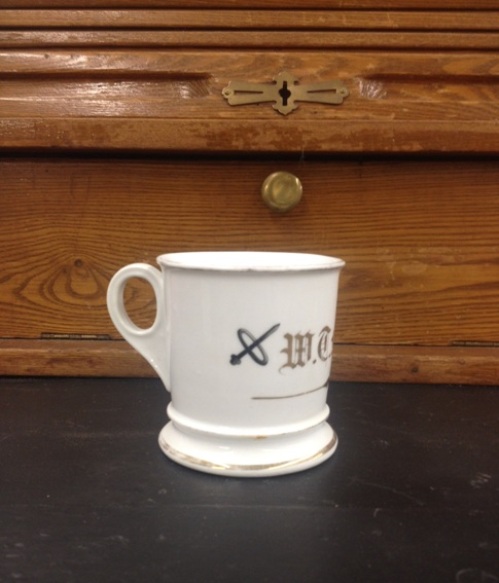 | |||
|
| Powered by Social Strata | Page 1 2 |
| Your request is being processed... |
|
Welcome Aboard IHC185™  Internet Horology Club 185
Internet Horology Club 185  IHC185™ Discussion Site Main Page
IHC185™ Discussion Site Main Page  Interesting Horologically Based Stories
Interesting Horologically Based Stories  Larry Buchan's ..."Tales from the Rails"
Larry Buchan's ..."Tales from the Rails"  BofRT ID Tag [Accident - Health Reference]
BofRT ID Tag [Accident - Health Reference]
 Internet Horology Club 185
Internet Horology Club 185  IHC185™ Discussion Site Main Page
IHC185™ Discussion Site Main Page  Interesting Horologically Based Stories
Interesting Horologically Based Stories  Larry Buchan's ..."Tales from the Rails"
Larry Buchan's ..."Tales from the Rails"  BofRT ID Tag [Accident - Health Reference]
BofRT ID Tag [Accident - Health Reference]©2002-2025 Internet Horology Club 185™ - Lindell V. Riddle President - All Rights Reserved Worldwide

